Thrill seekers have many reasons to visit South Africa. It’s one of the adventure capitals of the world and home to many adrenaline-inducing activities like shark cage diving, bungee jumping, and paragliding. Kruger National Park is the largest game reserve in Africa and your best chance to see the Big Five anywhere on the continent.
But South Africa isn’t just about adventure. It’s home to some of the best and most diverse food in Africa and a wine tradition that dates back to the middle of the 17th century.
As you’ll soon see from this article on traditional South African foods, people with a taste for adventure and great food will have much to look forward to in Cape Town and South Africa.
SOUTH AFRICAN FOOD QUICK LINKS
If you’re planning a trip to South Africa and want to really dig into the cuisine, then you may be interested in joining a food tour.
TOURS & OTHER SERVICES
- Food Tours: Food and Wine/Drinking Tours in South Africa
- eSIM: South Africa eSIM
Save This on Pinterest!
No time to read this South African food guide now? Click on the save button and pin it for later!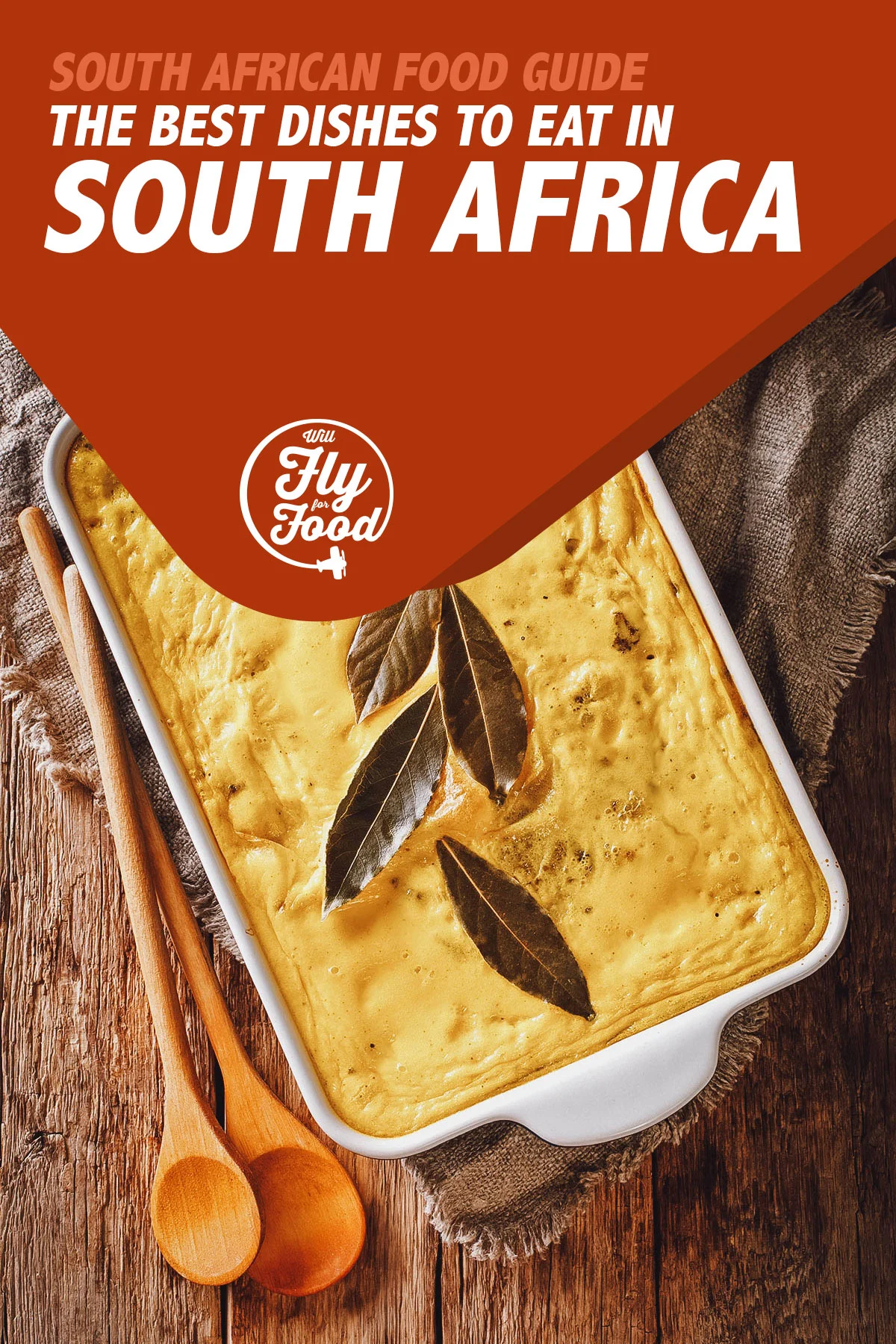
Photo by lenyvavsha
WHAT IS TRADITIONAL SOUTH AFRICAN FOOD?
Quickly scroll through this article and it becomes apparent that the food in South Africa is a fusion of indigenous cooking and many external cultural influences. These include Dutch, French, Indian, and Southeast Asian. Each made an indelible impact on the local food and culture, making South African food truly a global cuisine.
In the precolonial period, the South African diet consisted mainly of cooked grains (primarily maize), pumpkin, beans, fermented milk, and roasted or stewed meat. People kept sheep and goats but beef has always been the most coveted type of meat in South Africa. In fact, so prized was beef that ribs from slaughtered cattle were often offered to village chiefs.
The arrival of European settlers led to many changes in South African food. New spices and cooking methods were introduced though red meat continues to figure prominently and is still the centerpiece of any meal.
This is best exemplified by the braai or South African barbecue, a marathon of meat consisting of different types of red meat like sausages, chops, kebabs, and steaks cooked over a wood or charcoal fire. It’s a social event and a vital part of modern South African culture.
THE BEST IN SOUTH AFRICAN CUISINE
This guide on the traditional food in South Africa has been organized by category to make it easier to digest. Click on a link to jump to any section of the guide.
BRAAI
There’s no better way to start this food guide than with braai, a barbecuing tradition that’s as much a social custom in South Africa as it is a culinary event. What you’ll find in this section are South African foods typically associated with a braai.
1. Braai
As important a cultural tradition as asado is to Argentinians, so is braai to South Africans. Meaning “grilled meat” in Afrikaans, braai is short for braaivleis and is essentially the South African equivalent to a barbecue. Though for many South Africans, it means much more than that.
A typical braai in South Africa consists of a variety of meat like beef, pork, lamb, chicken, ostrich, seafood, boerewors (sausage), and sosatie (skewered meat) barbecued on a grill. Root crops, bread, and game meats like warthog, kudu, and springbok are often barbecued as well. An authentic braai is always fueled by wood (preferred) or charcoal and never with gas.
There are generally two types of braai – one where the braai master organizes the meat and another called “bring-and-braai” or “chop n’ dop” where the guests bring the meat while the braai master provides the side dishes. Common sides enjoyed at a braai include braaibrooodjie (grilled sandwiches), pap, and roosterbrood (bread).
Like an Argentinian asado, a braai is governed by tradition and can last for several hours. Guests gather around the grill to socialize and enjoy snacks like biltong and droëwors (dried meats) while watching the braai master in action. The word “watching” here is key. All the grilling is left to the braai master as it’s considered rude to intervene in any way.
In fact, there’s a popular saying in South Africa that goes: Jy krap nie aan ‘n ander man se vuur nie, which means “You don’t mess around with another man’s fire!”
More than just food, the braai is a cultural tradition in South Africa that transcends race and social class. It brings family and friends together and is the go-to social event to celebrate national holidays and milestones like birthdays and graduations.
A braai can be enjoyed at any time of the year though it becomes especially significant on Heritage Day. Known unofficially as “Braai Day”, people get together on September 24 for a barbecue to celebrate the many cultures and traditions that make up South Africa.
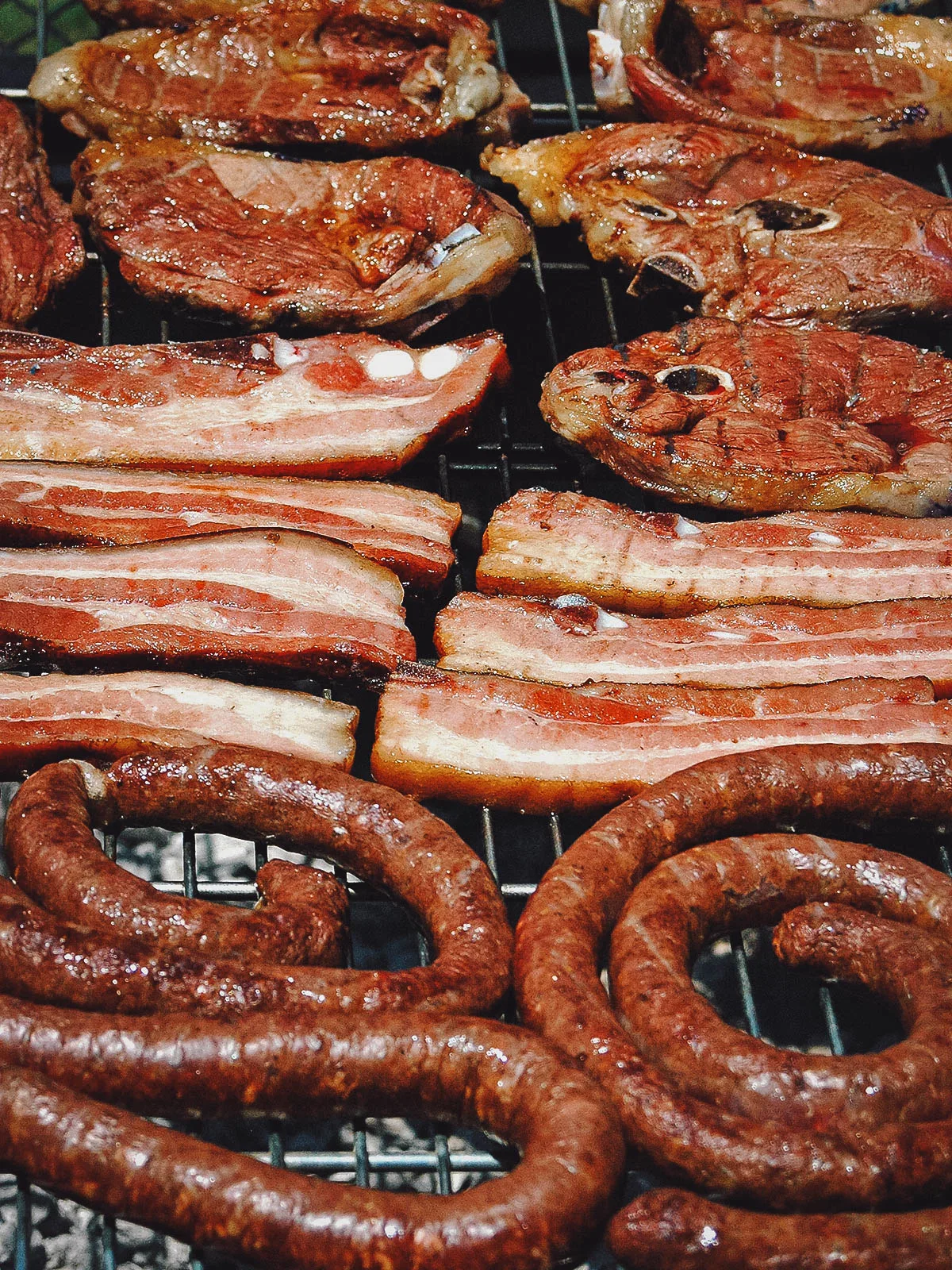
Photo by AnkevanWyk
2. Boerewors
Boerewors refers to a South African sausage that’s popular in the cuisines of countries in southern Africa like Namibia and Zimbabwe. Boer means “farmer” and wors means “sausage” in Afrikaans, so boerwors literally means “farmer’s sausage”.
Boerewors is made with coarsely minced beef and a host of different spices like coriander seed, nutmeg, cloves, allspice, and black pepper. The beef can be mixed with minced pork and/or lamb but authentic boerewors must always contain beef.
According to South Africa’s regulators, boerewors must be made with 90% meat and 10% spices and other ingredients. The meat component can be made with a maximum of 30% fat and must not contain any offal or mechanically separated meat.
Traditionally made into spiral form, boerewors is often braaied (barbecued) though it can be cooked in other ways as well. It’s a common sight at braais and is often eaten with pap (corn meal).
According to Guinness World Records, the longest boerewors ever made measured just over 1,557 meters long (almost 5,109 ft). Time for a braai!
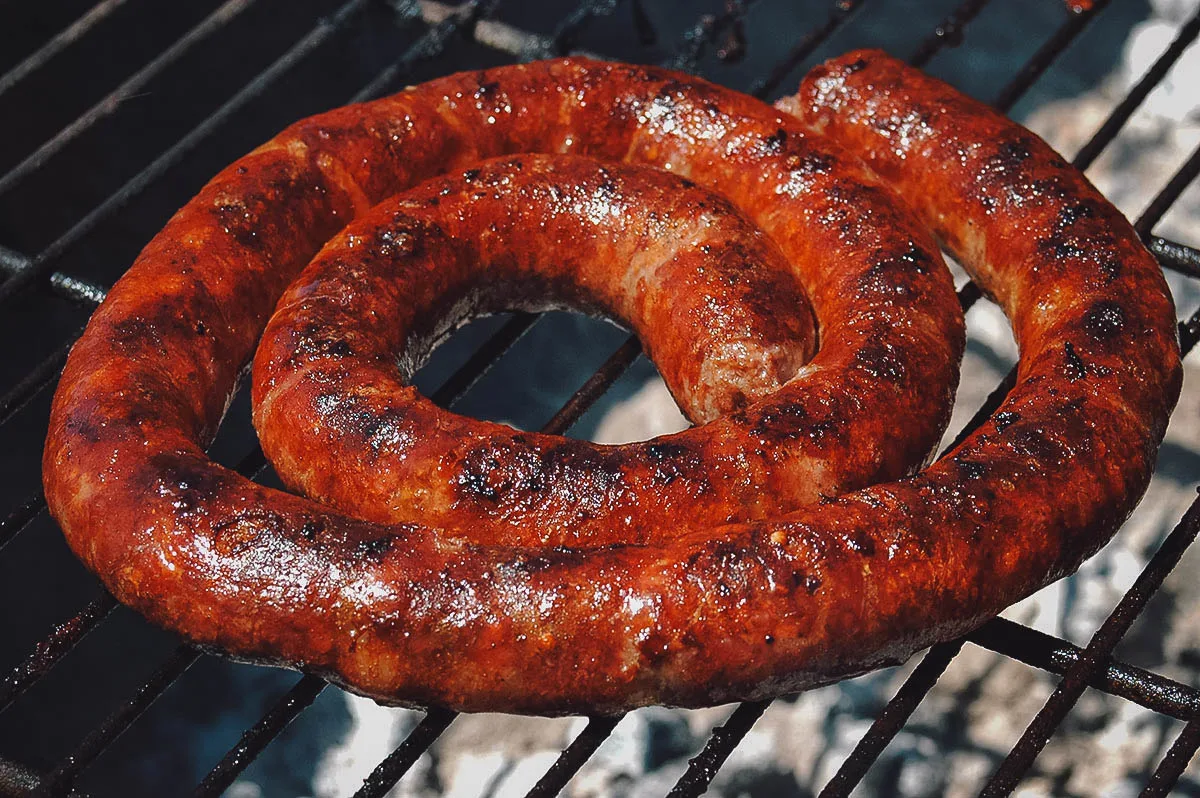
Photo by AnkevanWyk
3. Sosatie
The sosatie is another dish that’s often part of a traditional braai in South Africa. It refers to cubes of meat, usually lamb or mutton, skewered on sticks and cooked on a grill or pan-fried. A Cape Malay dish, the word sosatie is derived from saus meaning “spicy sauce” and sate which refers to skewered meat.
Recipes for sosatie vary but it’s typically made with chunks of meat that are marinated overnight in a mixture of fried onions, garlic, chili pepper, curry leaves, and tamarind juice. Lamb and mutton are most common though it can be made with beef or chicken as well. The meat is threaded onto skewers, often with onions and peppers interspersed between the meat, and then grilled.
Sosatie is one of the best examples of the Cape Malay influence on South Africa’s cuisine. The Cape Malays are descendants of formerly enslaved Asian and African Muslims who lived at the Cape during Dutch and British rule. When they were freed, many settled in the Bo-Kaap area of Cape Town and introduced a culinary tradition that’s become an important part of the traditional cuisine in South Africa.
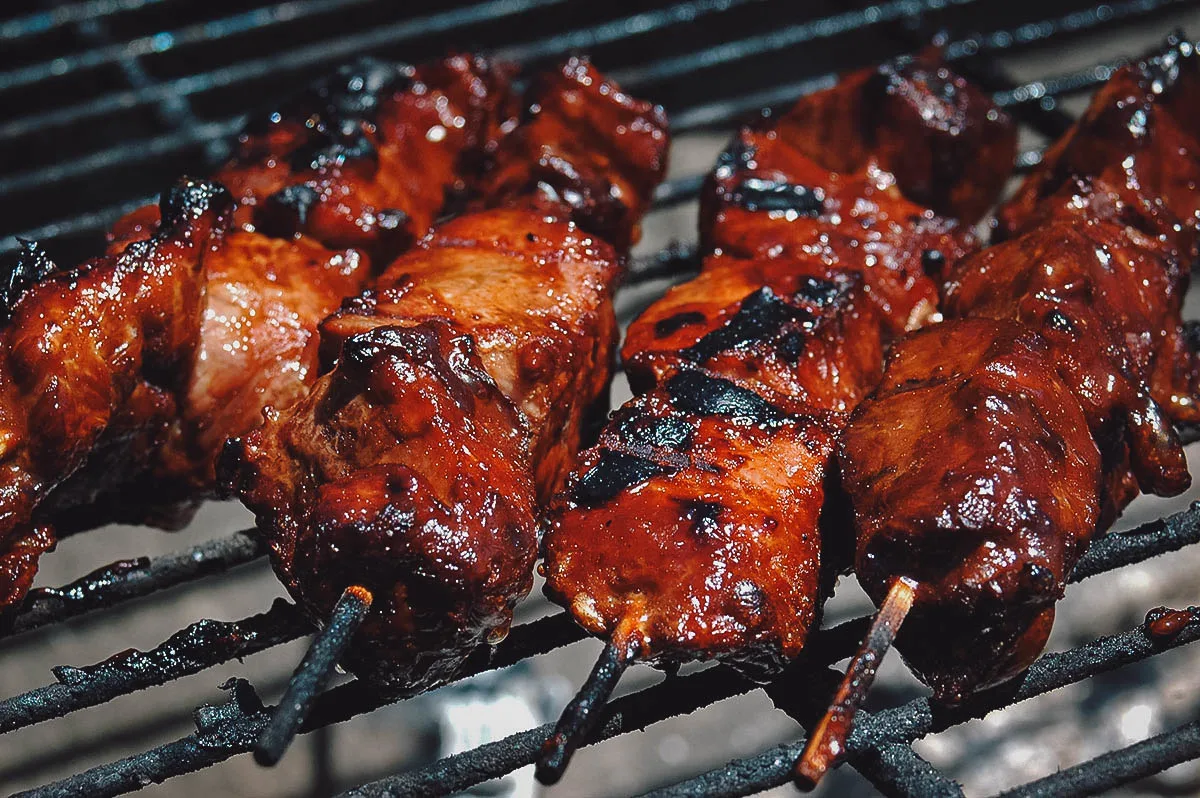
Photo by AnkevanWyk
4. Roosterbrood (Roosterkoek)
Roosterbrood or roosterkoek refers to a type of grilled bread made with flour, yeast, salt, sugar, and water. Like the meats at a braai, they’re cooked directly on the grill over a wood or charcoal fire.
Roosterbrood is known for being smokey and crusty on the outside but soft and doughy on the inside. It’s a popular side dish and the perfect foil to the juicy grilled meats of a braai.
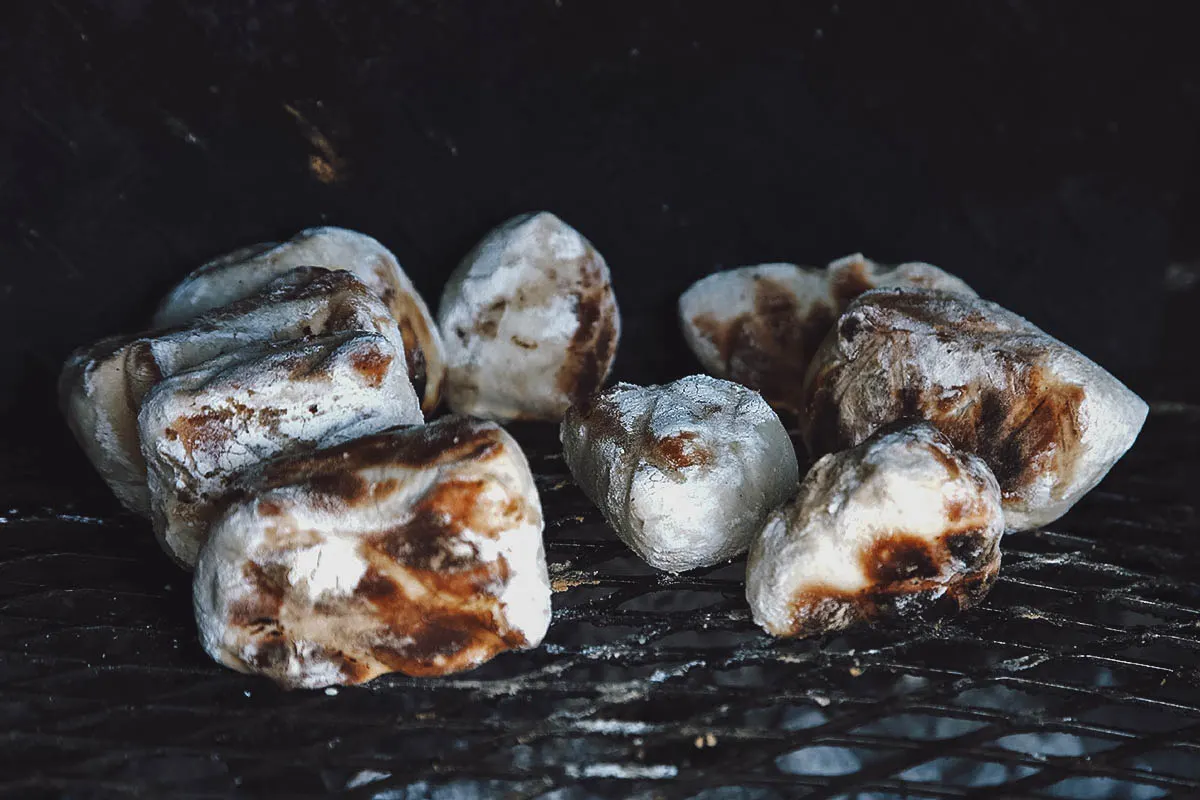
Photo by Wirestock
5. Braaibroodjie
Grilled cheese sandwiches are delicious any which way, but have you ever had one grilled over a wood or charcoal fire? A common side dish at braais, braaibroodjie translates to “barbecue bread” and refers to the South African version of the grilled cheese sandwich.
There are many variations of braaibroodjie but it’s typically made with two slices of buttered white bread, tomatoes, cheddar cheese, red onions, and chutney. If you aren’t familiar with it, chutney refers to a family of Indian condiments made popular in South Africa by the British.
Smokey, gooey, and crunchy, braaibroodjie is perhaps the second most popular dish at a braai, after the meats, and is typically served at the end of the meal.
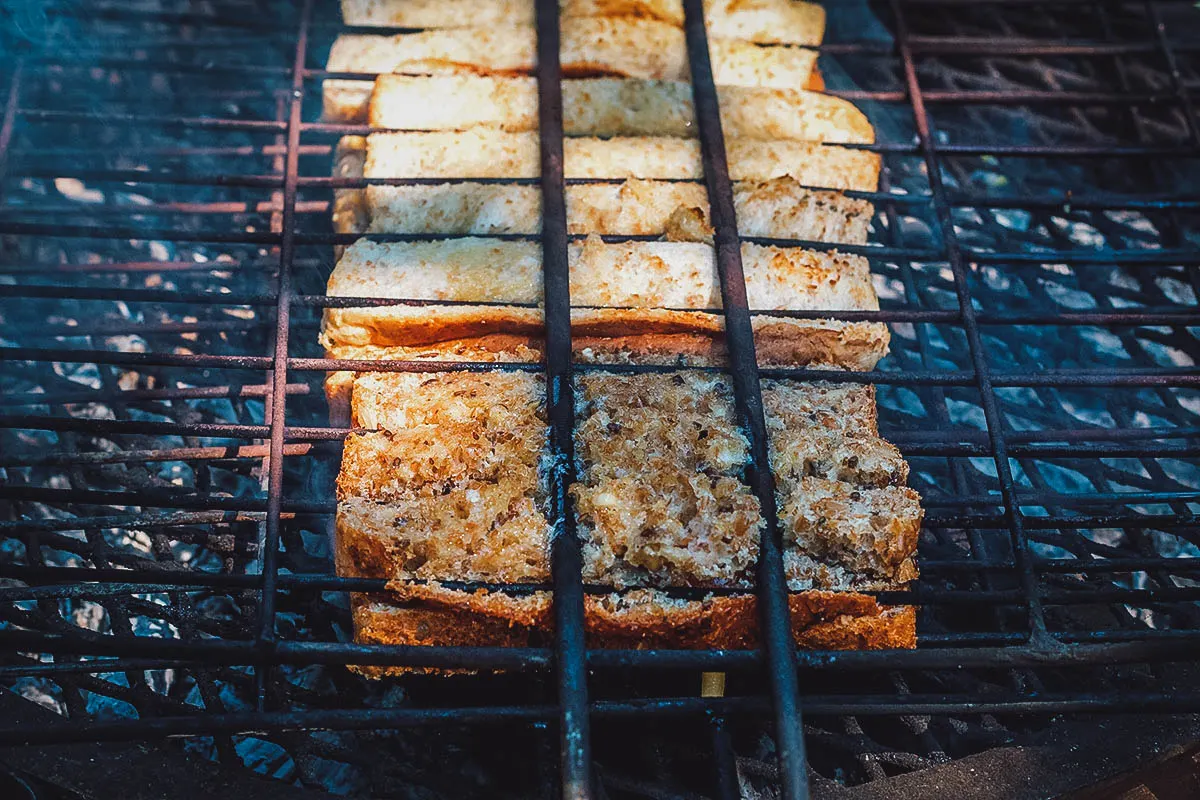
Photo by vanderspuyr
STARTERS / SNACKS / SIDES
6. Biltong / Droëwors
If you like meat jerky, then you’re going to enjoy biltong and droëwors. They’re the South African equivalent to American beef jerky, but much better.
Biltong refers to a type of dried cured meat popular in South Africa, Zimbabwe, Malawi, Botswana, Namibia, and Zambia. Cut into flat pieces or strips, it can be made with different types of meat like beef, chicken, fish, ostrich, and wild game meats like kudu or springbok.
Unlike beef jerky that’s sliced, marinated in spices and sugar, and then cooked, biltong is cured in vinegar and then air-dried whole before being cut into strips. The difference in process leads to a softer and more flavorful cut of dried meat. Vinegar is the key flavoring agent in biltong but spices like ground coriander seeds, rock salt, allspice, and black pepper add to its many layers of flavor.
When ready, biltong develops a deep meaty flavor with a texture that’s somewhere between jerky and Italian prosciutto. Aside from being softer and more flavorful than beef jerky, it’s also healthier because it’s made with less sugar. Biltong needs to be consumed within four days when fresh but with proper storage, it can keep for several months.
In South Africa, biltong is often enjoyed as a snack or used as an ingredient in many dishes like stews, sandwiches, and breads. Guests eagerly waiting for the meats to cook will often snack on biltong and droëwors at braais.
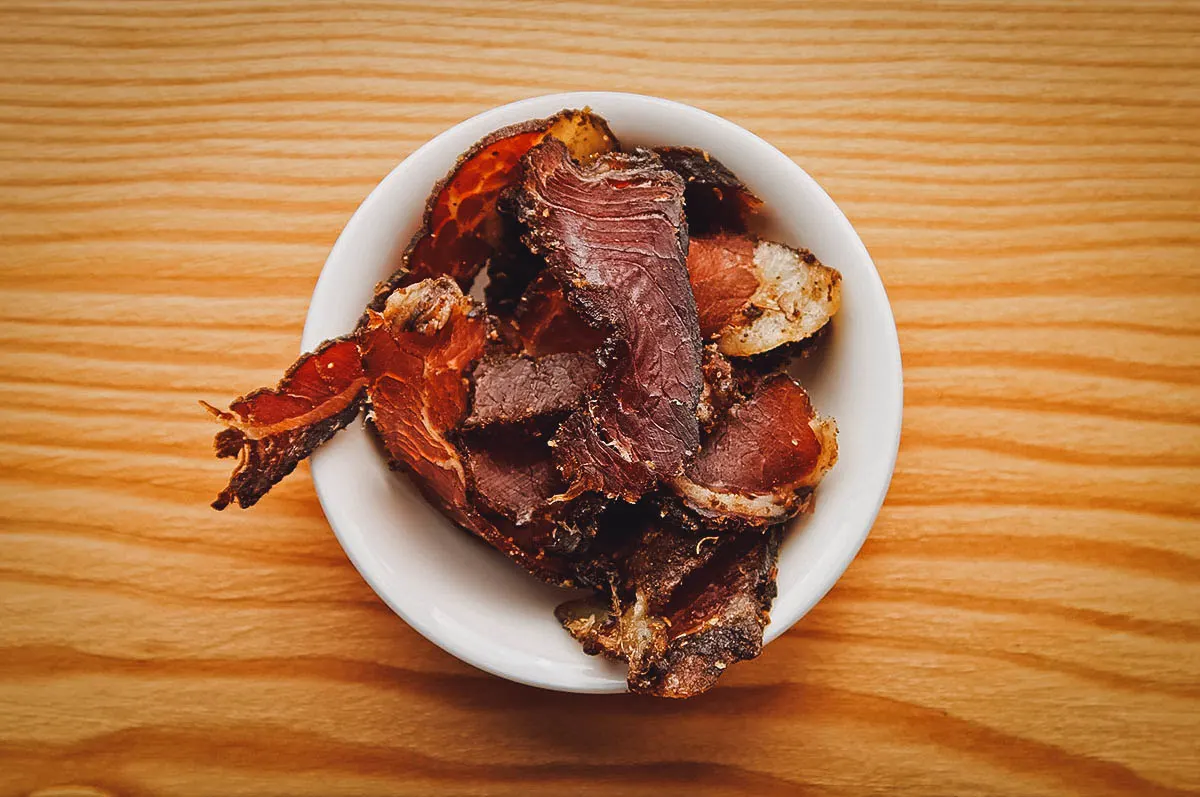
Photo by Wirestock
Like biltong, droëwors is a type of dried meat snack that’s widely consumed in South Africa. It refers to a type of dried sausage based on the popular boerewors. In Afrikaans, droë means “dry” while wors means “sausage”, so droëwors literally means “dry sausage”.
The recipe for droëwors is similar to boerewors except they’re made mainly with beef. Pork and veal, which are often used in boerewors, aren’t ideal for droëwors because they can go rancid when dried.
Droëwors are typically made into thinner sausages (dunwors) to help them dry faster and make them less prone to spoilage. They can sometimes be made into thicker sausages (dikwors) as well, but they need to be flattened first to provide a larger surface area for drying.
Droëwors are traditionally made with beef but they can be made with other meats as well like mutton, lamb, venison, and ostrich. Common seasonings include coriander, clovers, nutmeg, black pepper, salt, brown vinegar, garlic, and chili pepper. The ingredients are mixed together and then stuffed in thin sausage casings before being hung to dry for over a week. When ready, they can be eaten as is without the need for cooking or refrigeration.
Like biltong, it’s believed that droëwors was invented sometime in the 19th century as a way of creating a portable and durable food source. Migrating Dutch settlers called Voortrekkers needed food that would sustain them through the Great Trek. They needed food that would last and be easy to carry, so they started curing and drying meat to prolong its shelf life.
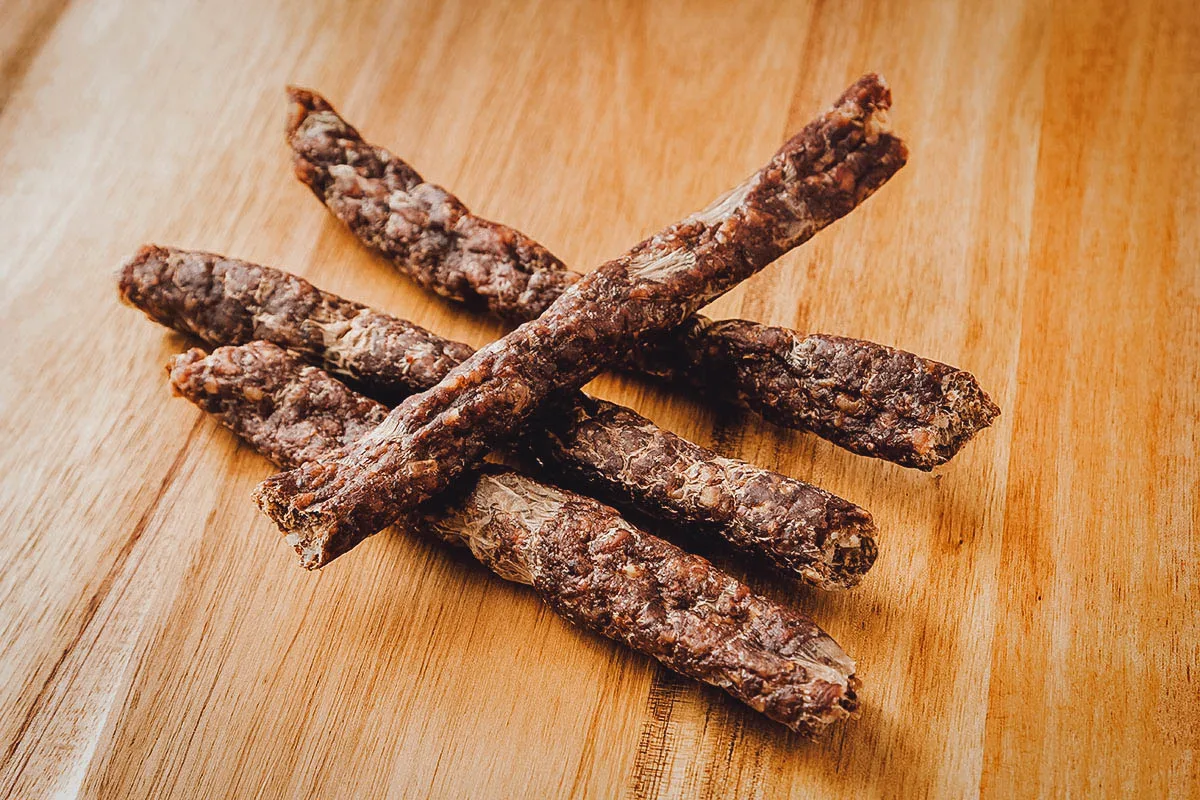
Photo by Wirestock
7. Samoosa
Between the mid-19th and early 20th centuries, thousands of indentured Indian workers were brought to South Africa to help develop the sugar industry in the former Natal province (now KwaZulu-Natal). With them came Indian dishes and culinary practices, some of which have become part of the traditional cuisine in South Africa. Among those dishes is the samoosa.
As you can probably guess, the samoosa is the South African version of the South Asian samosa, a baked or fried triangular pastry filled with a variety of savory ingredients. Recipes for samoosas vary but they’re typically made with a minced meat filling (usually beef, chicken, or lamb) flavored with garlic, ginger, onions, herbs, and spices.
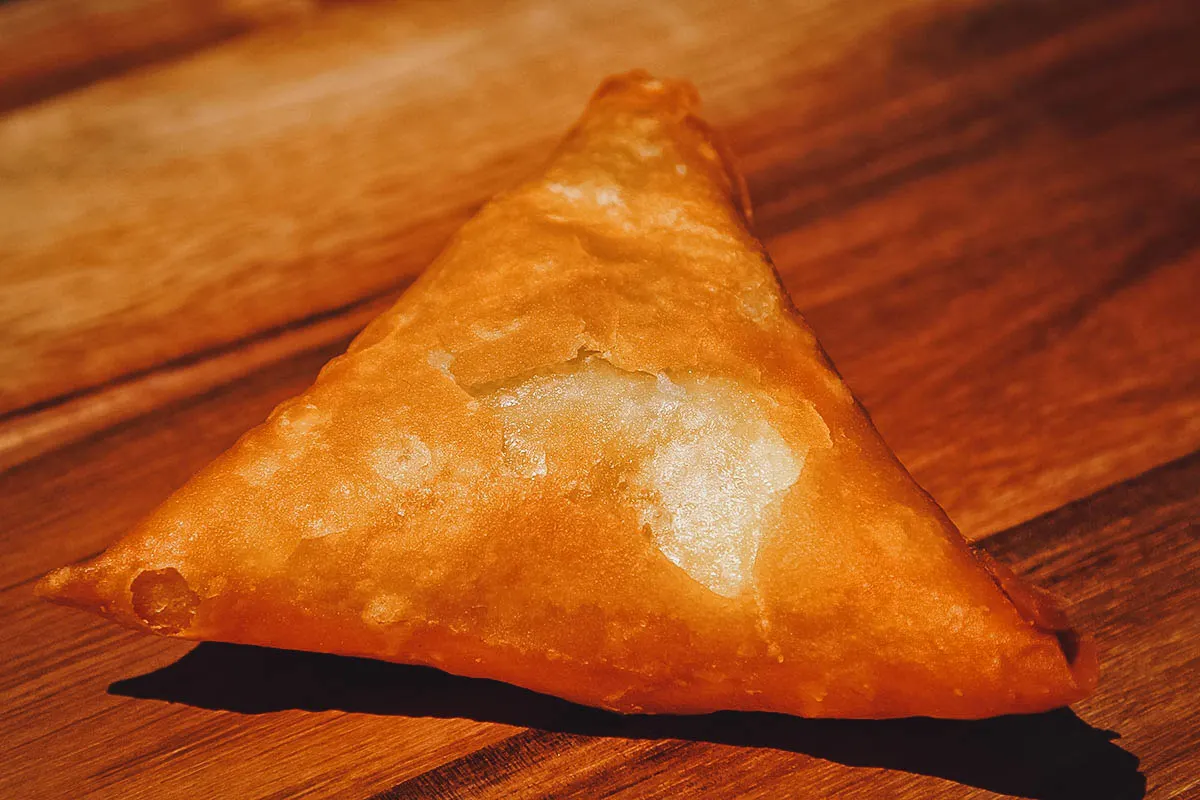
Photo by Wirestock
8. Amanqina Enkukhu
If you’re an adventurous eater and have a taste for unconventional food, then amanqina is right up your alley. Known colloquially as “walkie talkies” or “runaways”, it refers to a stew made with chicken feet. It’s a common township snack food popular throughout the country.
To make amanqina, chicken feet are boiled in water to remove the outer layer of skin. They’re then seasoned with various spices like curry powder, turmeric, salt, and black pepper before being stewed, fried, or barbecued. When ready, they’re often enjoyed as a snack with pap.
Amanqina isn’t for everyone but if you’re accustomed to eating chicken feet at Chinese dim sum restaurants, then this delicacy should be a walk in the park. It can be made with cow, pig, or sheep heels as well.
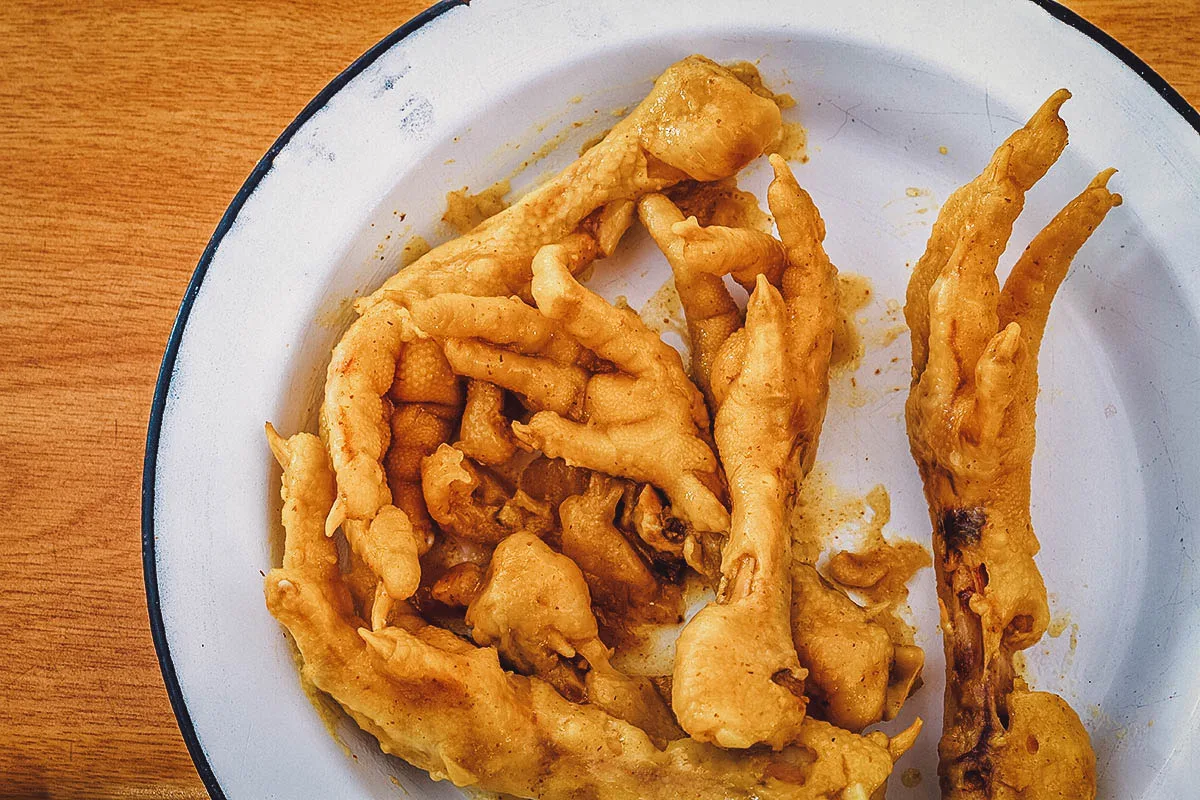
Photo by vanderspuyr
9. Monkey Gland Sauce
This oddly named condiment has been a staple item on South Africa’s restaurant menus for decades. Monkey gland sauce refers to a sweet and tangy sauce typically served as a topping for grilled steaks and burgers. Recipes vary but it’s typically made with chutney and tomato sauce along with other ingredients like onions, garlic, vinegar, soy sauce, ketchup, mustard, and Worcestershire sauce.
In spite of its name, monkey gland sauce has nothing to with monkeys or their glands. There are several theories as to how it got its name. The most popular asserts that the sauce was named in honor of a French scientist – Dr. Abrahamovitch Serge Voronoff – who was conducting experiments to cure impotence in men. He would graft monkey testicle tissue onto the testicles of impotent men in an attempt to restore their vigor.
Dr. Voronoff was a regular at the Savoy Hotel in London and often ordered a brandied steak which the restaurant staff nicknamed “monkey gland sauce” in honor of his experiments. One of the hotel staff’s waiters would later move to South Africa and bring the dish with him.
Regardless of its true origins, monkey gland sauce has become a widely consumed condiment in South Africa. Aside from burgers and steaks, it’s also used as a marinade and dipping sauce for roasted potatoes, onion rings, and french fries.
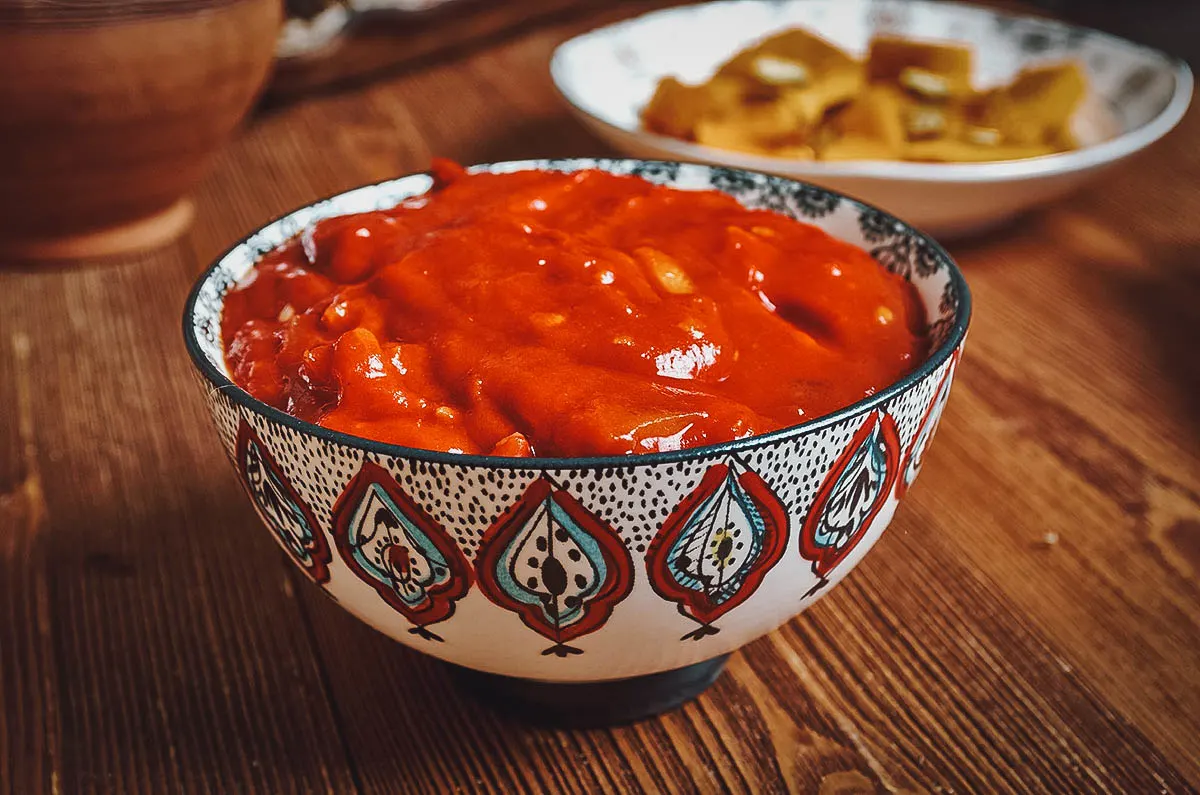
Photo by fanfon
MEATS / MAINS
10. Potjiekos
The word potjiekos literally means “small pot food” and refers to a traditional South African dish cooked in a round cast-iron cauldron called a potjie. Used outdoors and fueled by a wood or charcoal fire, the potjie is descended from the Dutch oven and is a common apparatus found in many homes and villages throughout the country.
Traditionally, potjiekos is made with meat (often lamb or pork) and various vegetables like carrots, cabbage, potatoes, onions, cauliflower, and green beans. The ingredients are seasoned with Dutch-Malay spices and some form of alcohol like beer or sherry before being slow cooked over a low fire. Little sauce or water is added so the ingredients are steamed and not boiled in the manner of a stew.
What makes potjiekos different from a traditional stew is that the pot is never stirred. This is to ensure that the flavors from the different ingredients stay separate during the cooking process. When a potjiekos is cooked properly, the distinct flavors of each ingredient should still be discernible.
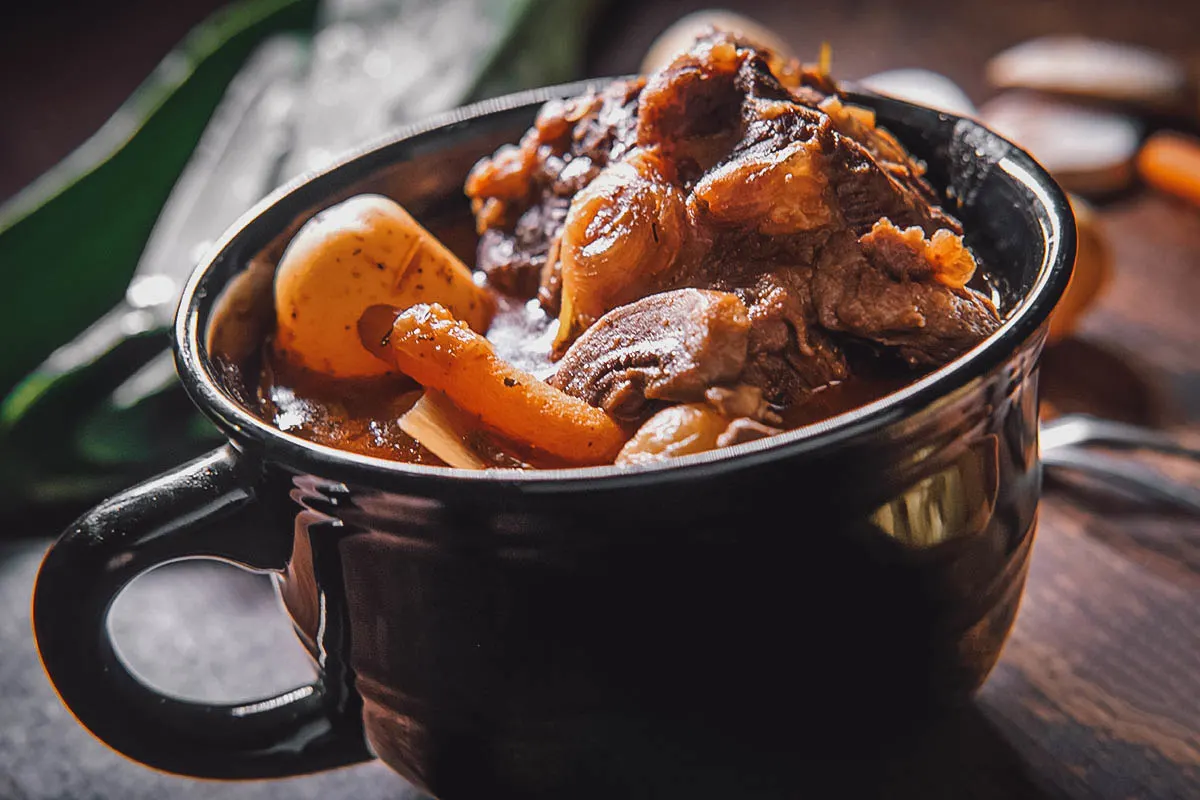
Photo by ezumeimages
This is what the potjie looks like. It’s a three-legged cast-iron cauldron introduced to South Africa by Dutch explorers who arrived at the Cape of Good Hope in the middle of the 17th century. The cauldron and dish eventually spread throughout South Africa when the Voortrekkers migrated east.
Today, potjiekos remains a popular dish throughout the country. Like the braai, it’s a communal dish that’s cooked and enjoyed outdoors with friends and family.
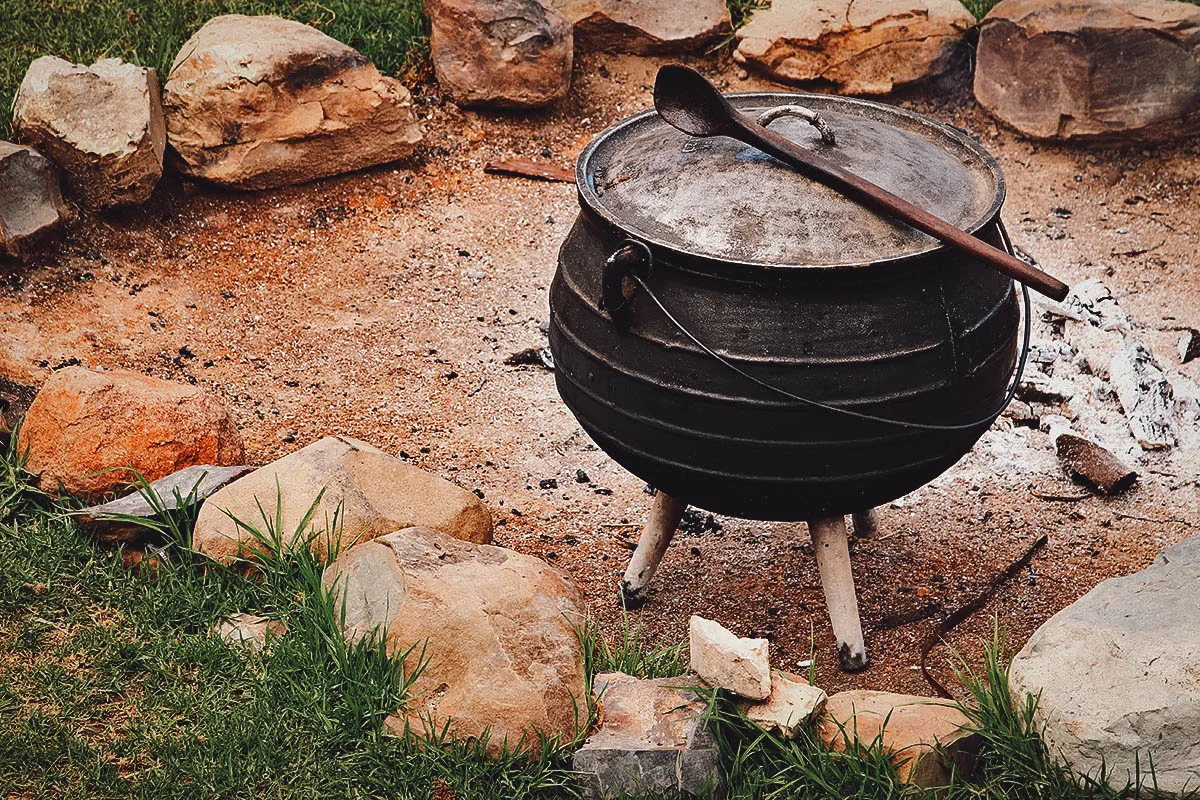
Photo by Wirestock
11. Frikkadel
Frikkadel is another example of the Dutch influence on South African cuisine. Popular in the Netherlands and in other countries throughout Europe, it refers to a lightly spiced meatball dish often served with a sweetened tomato sauce.
To make frikkadel, ground beef is mixed with onions, eggs, garlic, salt, black pepper, butter, herbs, and spices. That sounds like any typical recipe but what makes South Africa’s version unique is its use of soaked white bread as a binder. This helps keep the meatballs soft and very juicy. The meat mixture is then formed into balls or patties before being baked or deep-fried.
Frikkadel can be eaten hot or cold, served as is or with a chunky and herby tomato sauce called sheba sauce. It’s similar to a classic Italian tomato sauce except it’s made sweeter with onions and sugar.
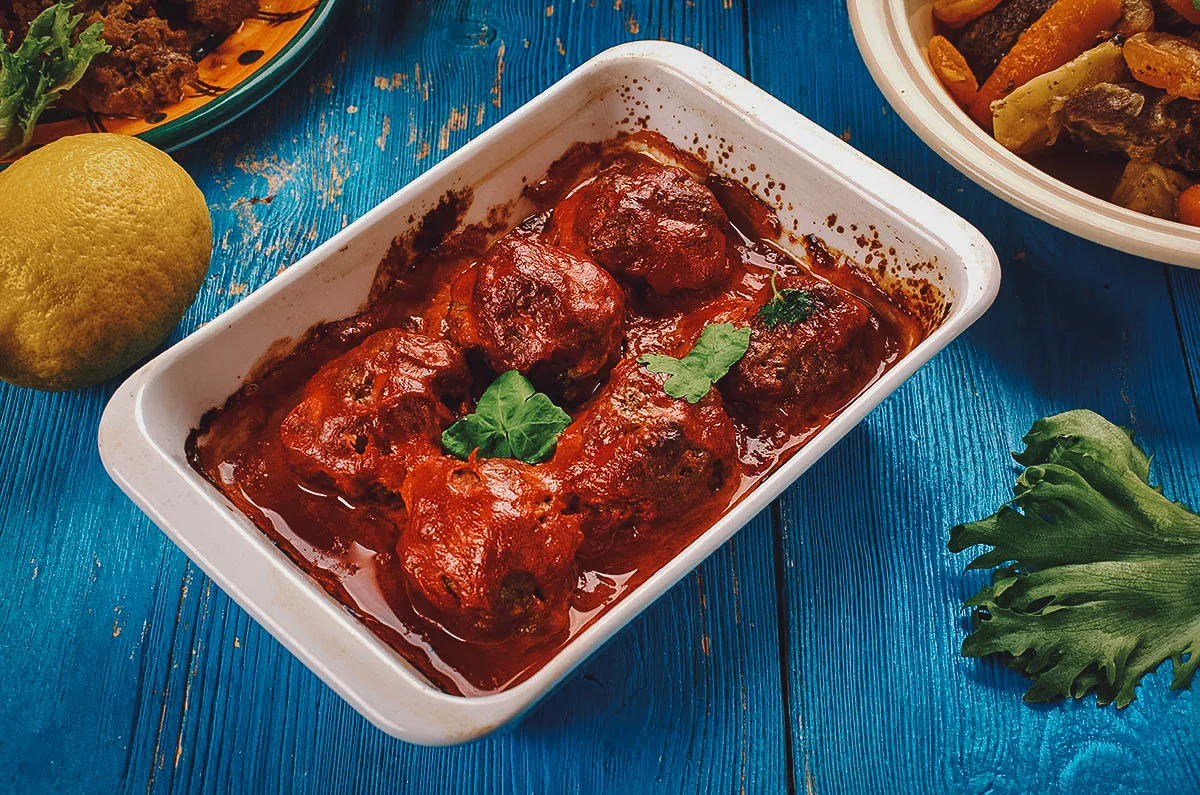
Photo by fanfon
12. Mala Mogodu
If you’re a fan of tripe, then mala mogodu is right up your alley. Popular in the cuisines of South Africa, Lesotho, and Botswana, it refers to a traditional stew made with beef tripe and intestines simmered with onions, garlic, peppers, tomatoes, herbs, and spices.
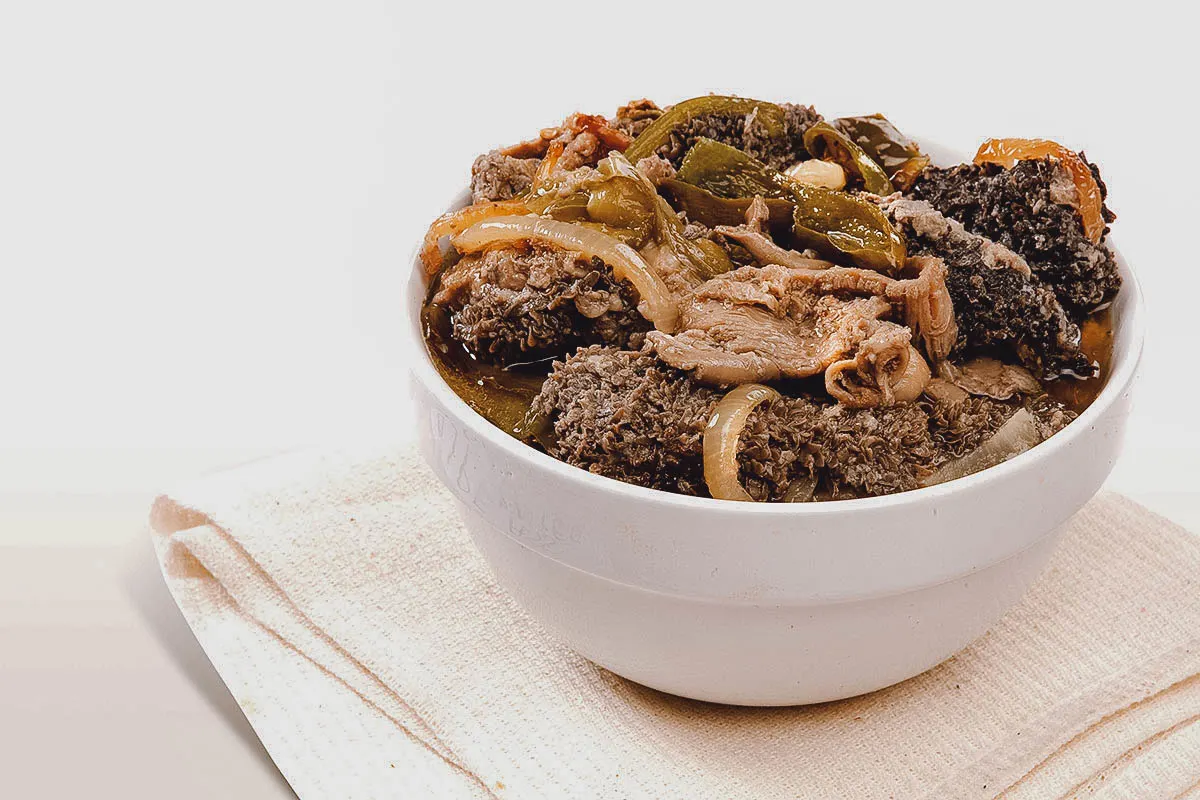
Photo by stockbp
13. Tomato Bredie
Tomato bredie refers to a type of stew made with mutton or lamb. Known in Afrikaans as tamatiebredie, It’s another delicious example of the Cape Malay influence on South African cuisine.
To prepare, fatty and bony cuts of mutton or lamb are covered in flour and browned. They’re then stewed with a variety of vegetables like tomatoes, green beans, pumpkin, cauliflower, and lentils. The meat and vegetables are slowly simmered till tender and flavored with a host of spices and seasonings like ginger, cinnamon, cardamom, cloves, and chili.
What makes tomato bredie unique is that it isn’t made with any water. It’s essentially a self-saucing dish that forms a gravy from the reduced tomatoes and the rendered fat and juices from the meat. When ready, it’s traditionally served with fluffy white rice.
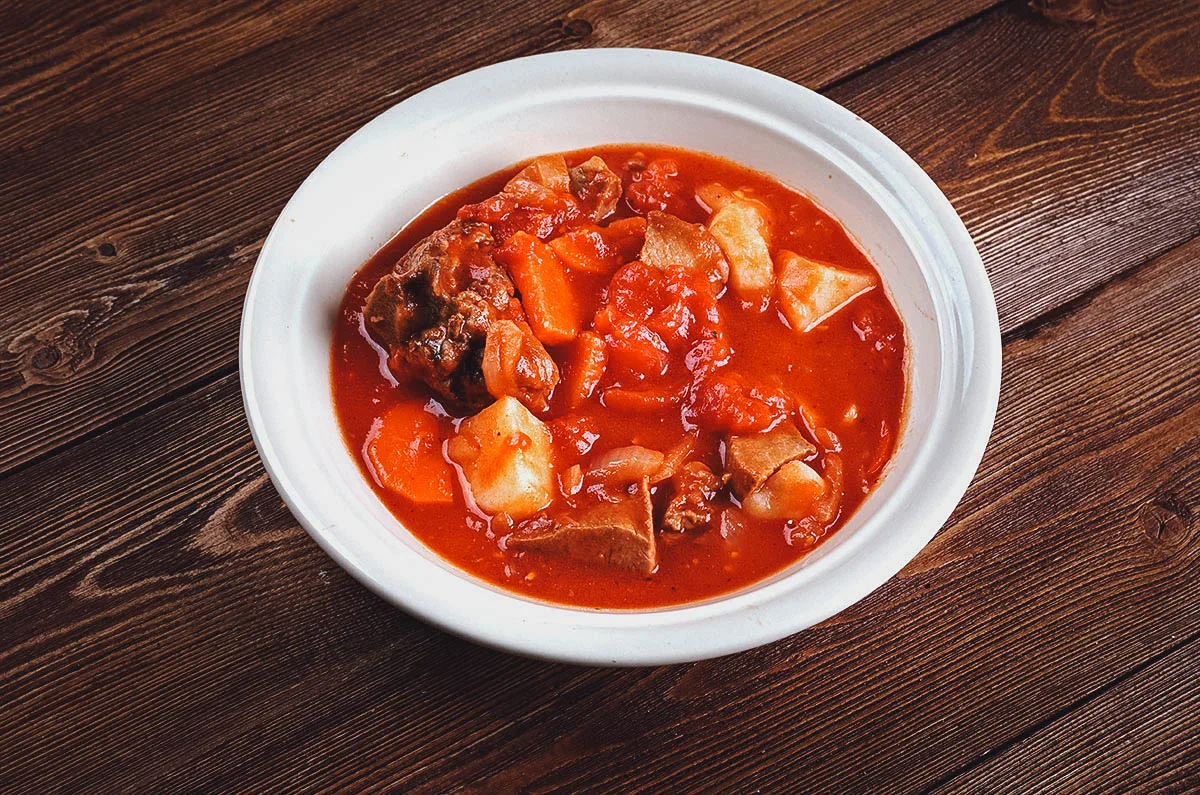
Photo by fanfon
14. Cape Malay Curry
This curry dish is perhaps one of the tastiest and most popular examples of the Cape Malay influence on South African food. It refers to a type of South African curry made with meat (often lamb or chicken) cooked with garlic, ginger, onions, tomatoes, potatoes, and a host of spices like cumin, coriander, turmeric, and masala powder. It’s usually served with rice and eaten without the use of utensils.
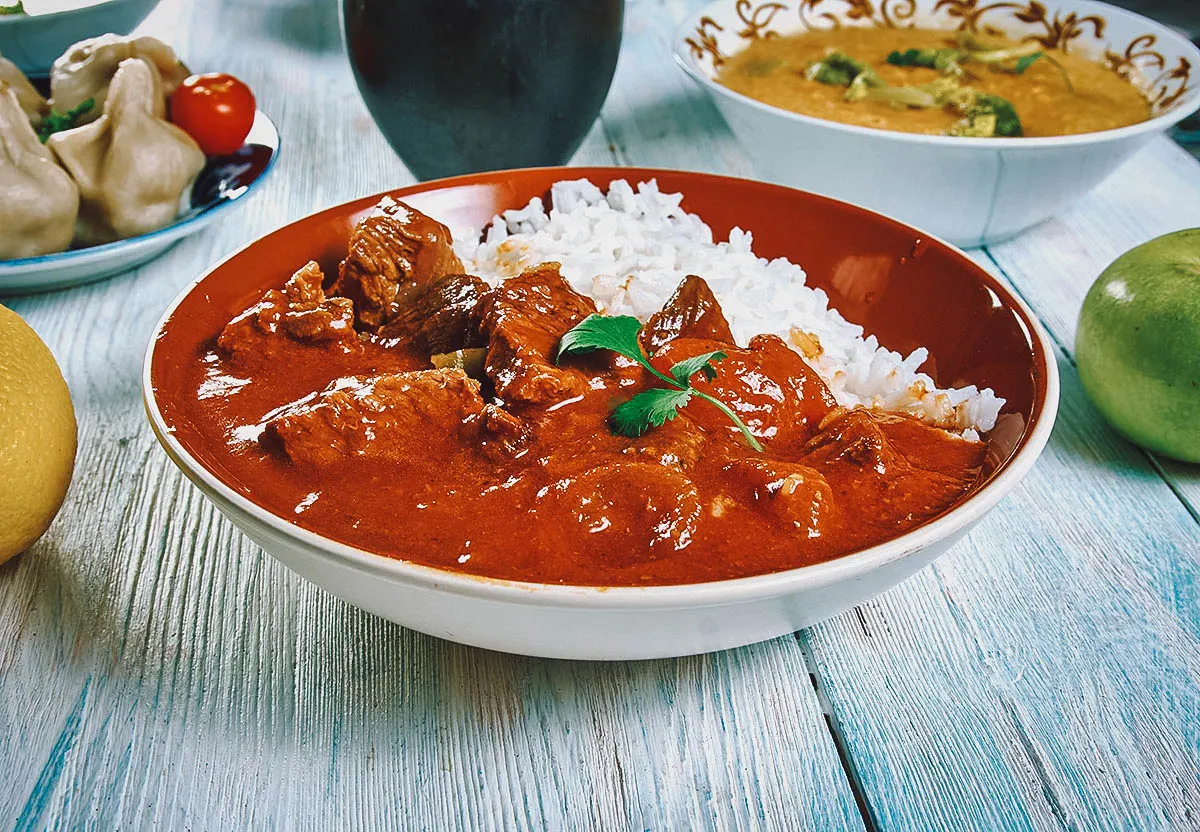
Photo by fanfon
15. Denningvleis
Denningvleis refers to a South African stew made with meat simmered with onions, garlic, tamarind paste, and different spices like cloves, allspice, and bay leaves. A Cape Malay dish, its name stems from the Javanese word dendeng, which refers to water buffalo meat. But in South Africa, lamb or mutton is typically used.
Denningvleis is usually paired with mashed potatoes, white rice, or geelrys – a type of South African yellow rice.
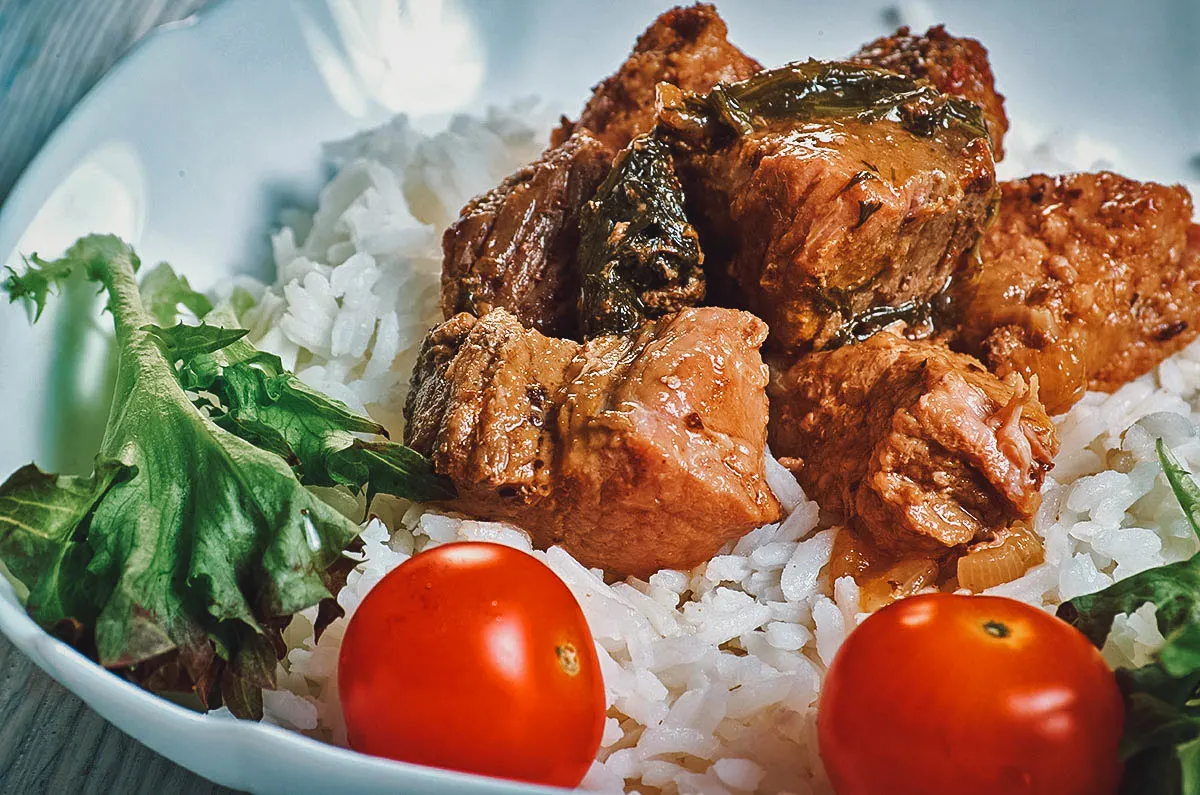
Photo by fanfon
16. Biryani
Fans of this aromatic rice dish will recognize that biryani is another example of the Indian influence on South African cuisine. It refers to a popular dish of Indian origin made with meat (usually lamb or chicken) layered with basmati rice, potatoes, and lentils seasoned with a host of herbs and spices like saffron, cinnamon, cardamom, cloves, cumin, turmeric, mint, and coriander.
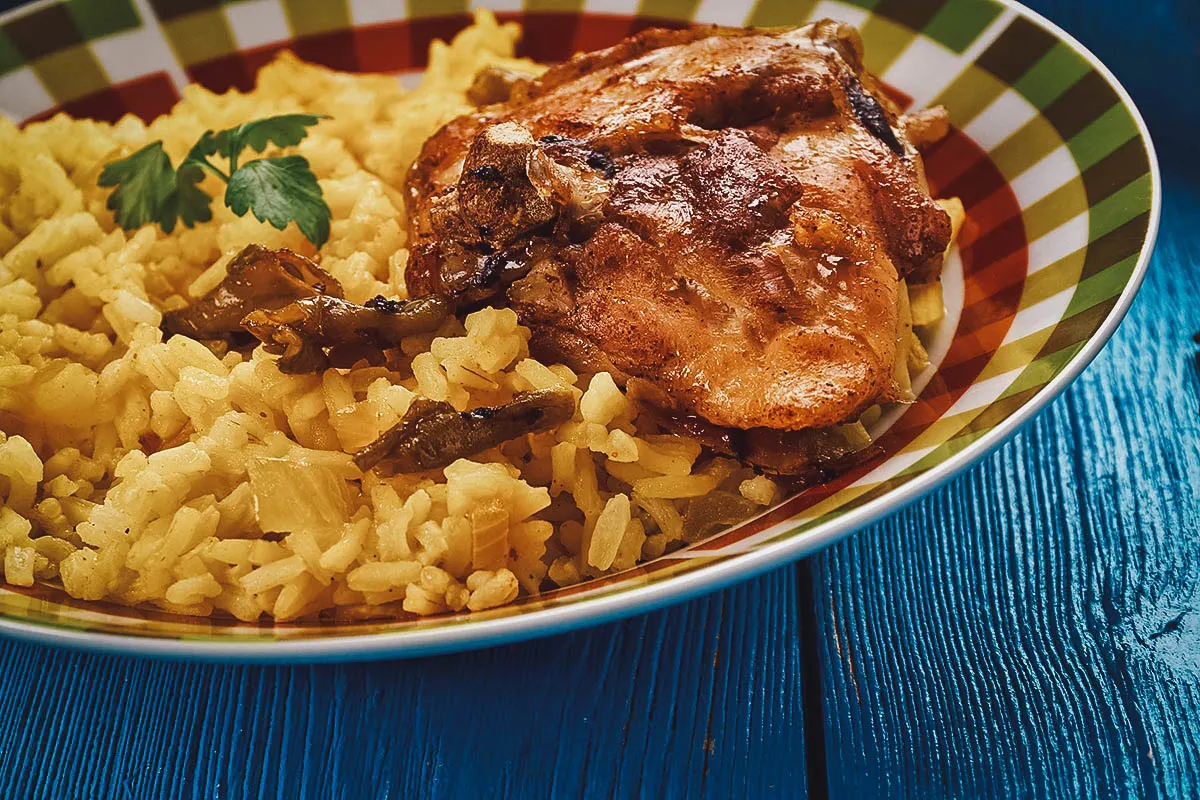
Photo by fanfon
17. Hoenderpastei (Boer Chicken Pie)
Hoenderpastei or boer chicken pie refers to a type of chicken pot pie popular in South Africa. It’s made with chicken layered with vegetables, hard-boiled eggs, and ham seasoned with lemon juice, bay leaves, pepper, and salt. The dish is topped with shortcrust pastry and then baked in an oven till golden brown and crispy.
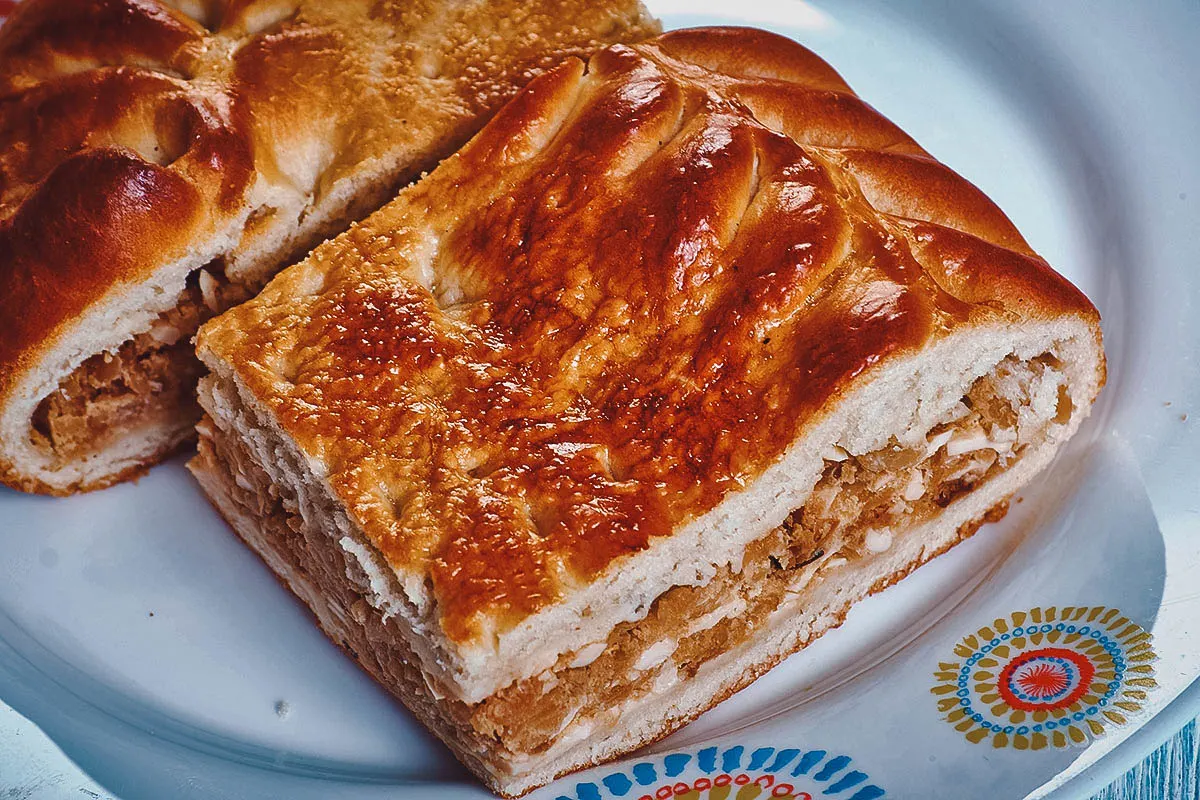
Photo by fanfon
18. Bobotie
Bobotie refers to a popular South African dish made with curried meat and dried fruit baked with a thin egg-based topping. Similar to moussaka, it’s one of the most well-known examples of Cape Malay food and is widely regarded to be a national dish of South Africa.
To make bobotie, ground beef or lamb is cooked with onions, grated apple, raisins, milk-soaked bread, and egg. The mixture is seasoned with lemon juice, Worcestershire sauce, and various spices like turmeric, cumin, coriander, and curry powder. The mixture is pressed into a casserole dish and then topped with milk and egg before baking. When ready, it’s typically garnished with bay leaves and often served with South African yellow rice.
Not a meat eater? No worries, you can enjoy a vegan or vegetarian version of bobotie made with lentils instead.
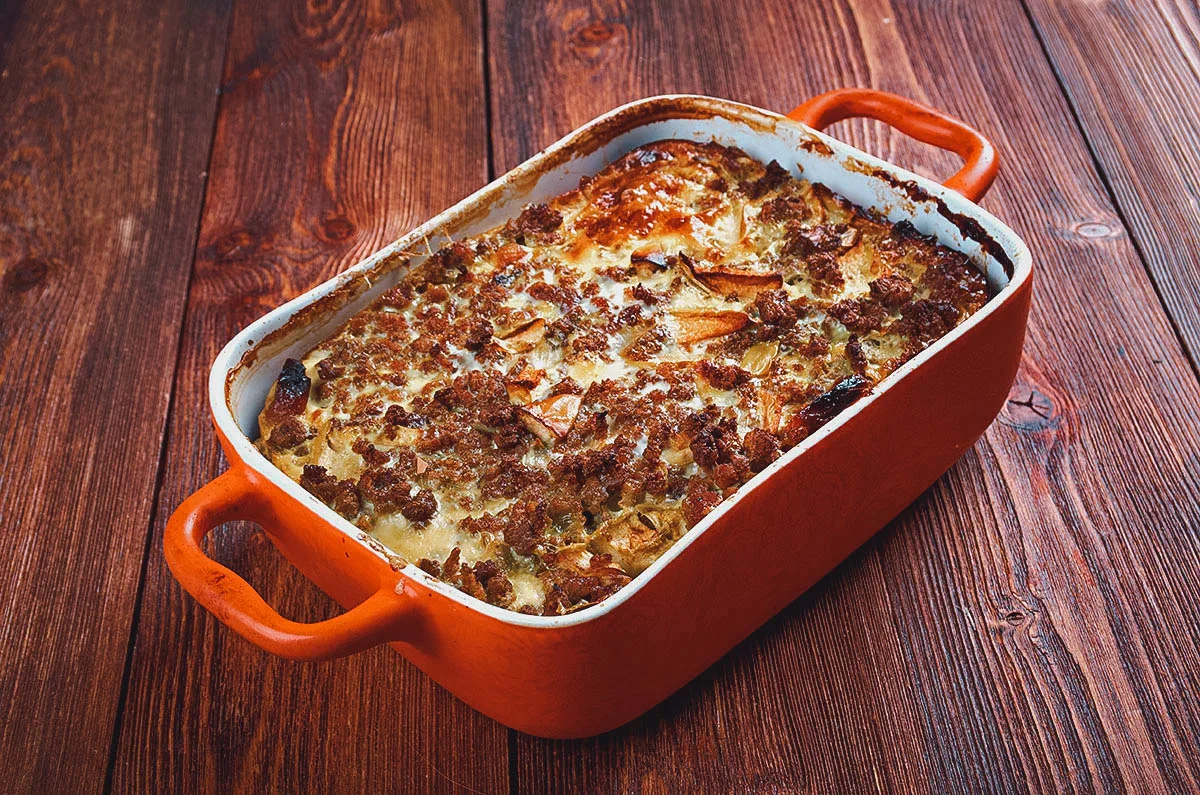
Photo by fanfon
STAPLES / BREAD
19. Pap
This isn’t the most exciting example of South African food but it’s one of the most important. Pap is the South African equivalent to Kenyan or Tanzanian ugali, a staple food that’s consumed throughout Africa.
Pap refers to a type of fluffy porridge made from maize meal (coarsely ground maize). Depending on how it’s cooked, it can be runny, soft, or stiff. Pap with a smoother consistency is called slap pap or soft porridge while thicker pap is known as stywe pap. A crumblier version of pap called phuthu pap (or uputhu, krummel) is also common.
Similar to American grits, pap can be eaten at any time of the day with other dishes. At breakfast, it’s usually enjoyed with butter, sugar, and milk. For lunch or dinner, it’s paired with a variety of more substantial meat and vegetable dishes like stews, curries, braai, and boerewors. It can even be watered down and fermented to produce a drink called mageu.
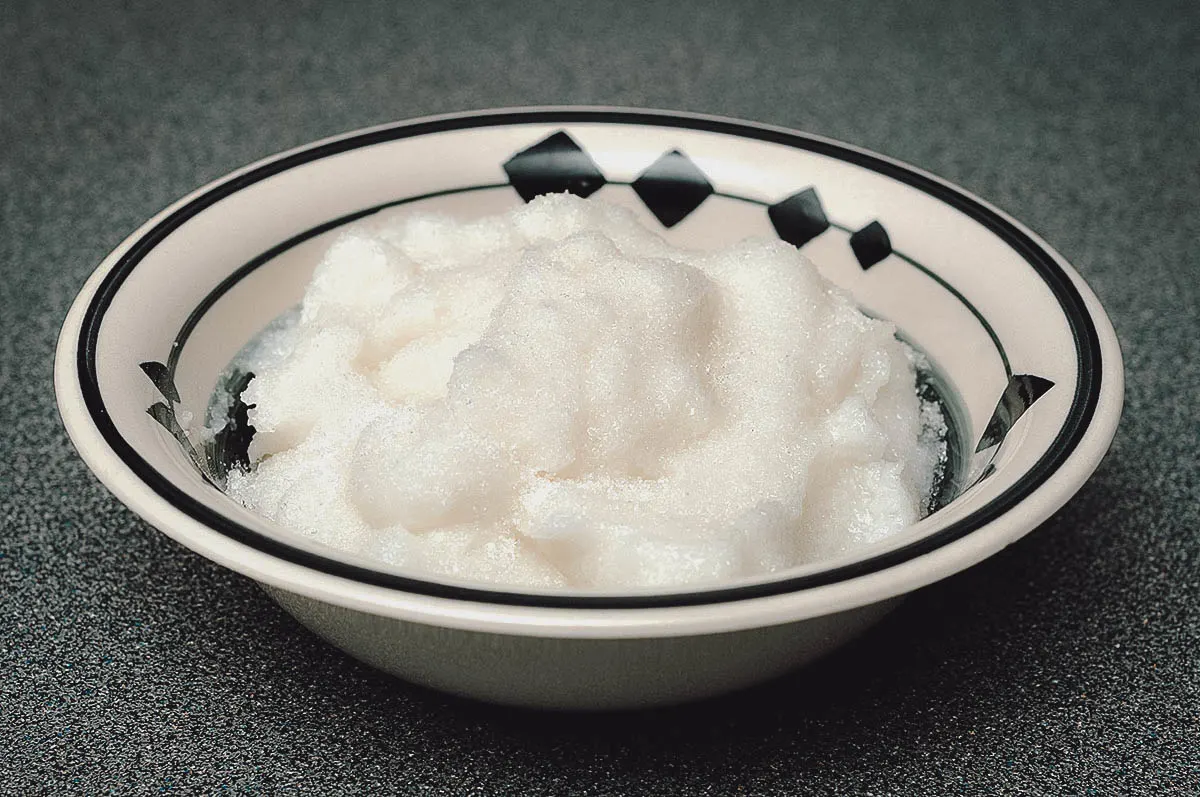
Photo by Marietjie
20. Umngqusho
Umngqusho is a popular dish made with samp and beans. Samp refers to a staple food made with dried, pounded, and chopped corn kernels. It’s similar to mealie meal except it isn’t as finely ground.
Samp can be consumed in many ways but one of the most common preparations is to cook it with sugar beans. The samp and beans are soaked overnight before being slowly simmered until soft. Recipes for umngqusho vary but it’s often cooked with onions, garlic, and potatoes and seasoned with various spices like curry powder, cloves, allspice, and black pepper.
Umngqusho can be eaten as is or paired with other dishes like chakalaka. It can also be made into a more substantial dish by adding meats like beef, lamb, or poultry.
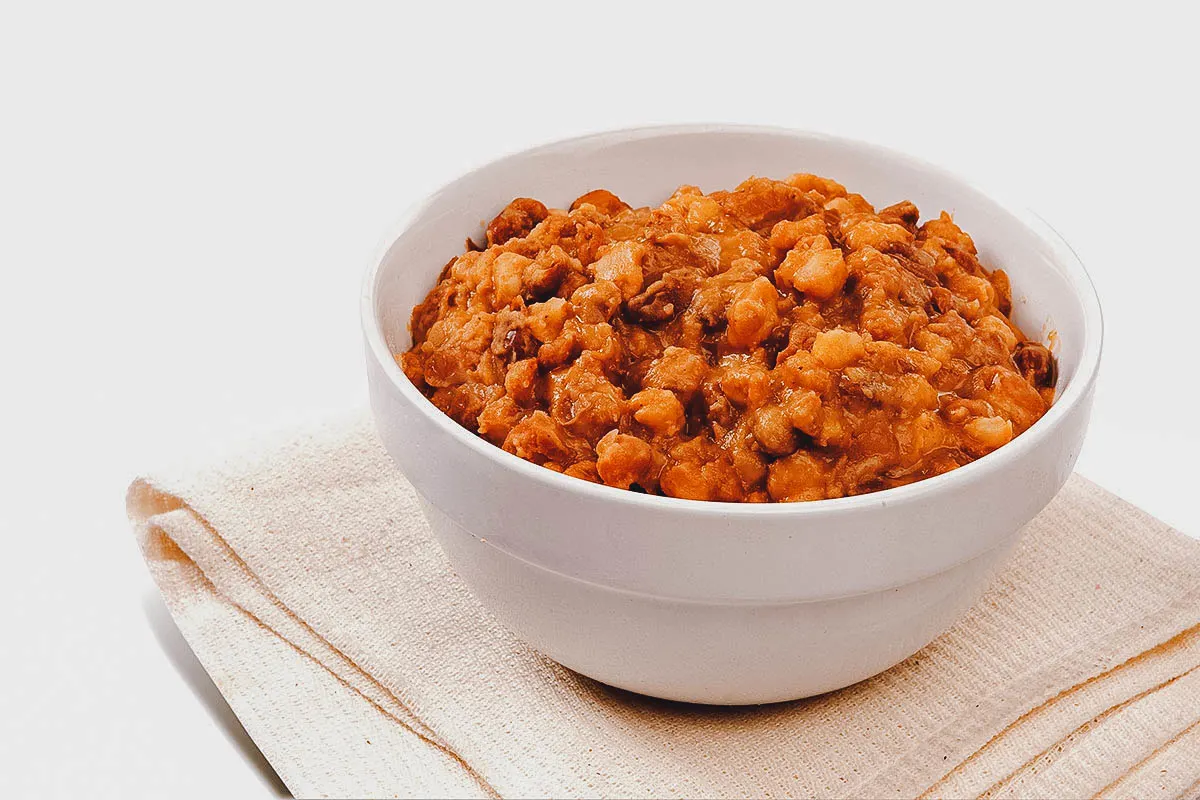
Photo by stockbp
21. Bunny Chow
Bunny chow, or bunny for short, is a popular street food dish that originated from the Indian community of Durban. Also known as kota or scambane, it consists of a hollowed out loaf of soft white bread filled with mutton curry.
Invented sometime in the mid 20th century, the exact origins of this dish are unclear. One theory claims that it was invented as a way for Indian sugar cane workers to easily transport their lunch to the field. White bread was a cheap substitute for roti and made for a convenient way to transport their curries.
Another story claims that a South African restaurant run by Banais (an Indian caste) was the first to serve this dish, hence the name bunny chow. Others believe that the dish may have been invented by Indian golf caddies who were banned from using sharp cutlery during apartheid. They devised the dish as a way of easily carrying and consuming their food using only their hands.
Whatever its true origins, this street food dish increased in popularity during the apartheid era. It became a practical lunch for Indian and Black South Africans who were barred from entering many establishments.
Bunny chow can be made with quarter, half, or full loaves. The loaf is hollowed out then filled with mutton, chicken, or bean curries. The dish has become so common that simply saying “quarter mutton” is enough for vendors to know what you want.
The dish is traditionally wrapped in newspaper and eaten on the go by hand, using the hunk of removed bread for dipping. It’s a tasty but messy dish that’s best eaten quickly before the bread gets soaked through with the curry.
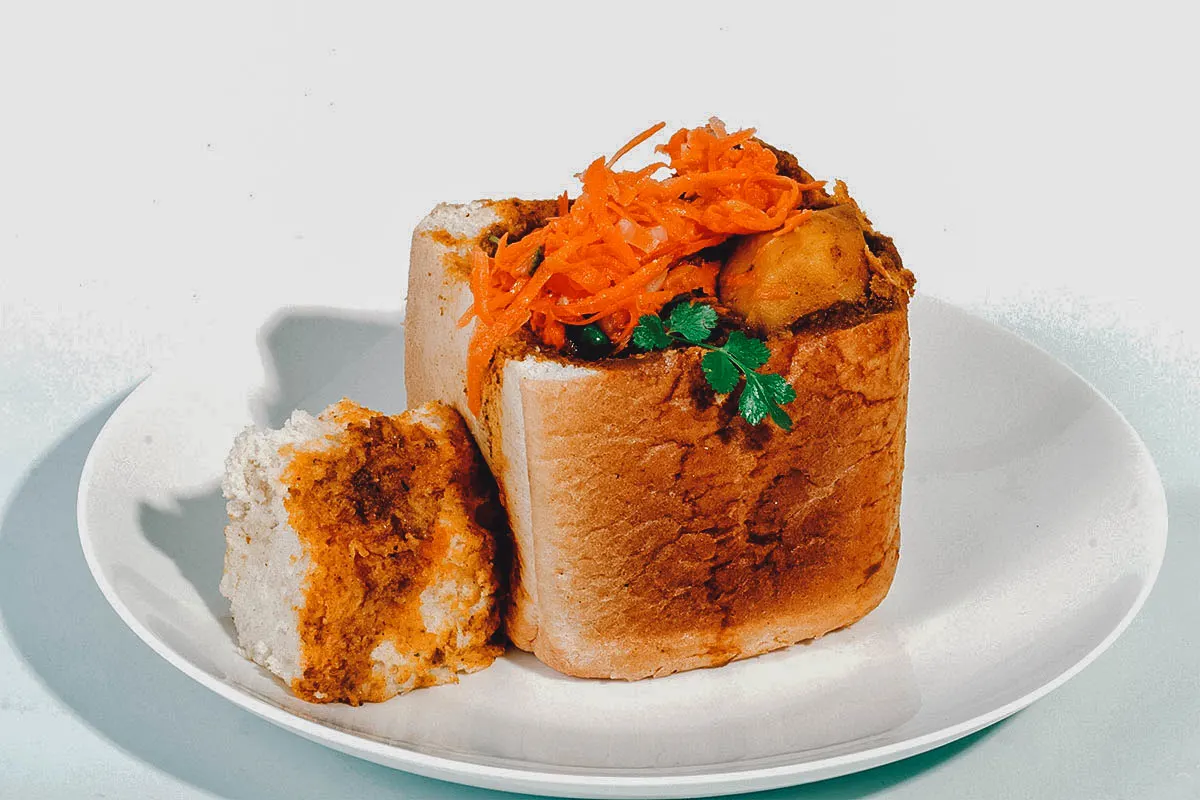
Photo by lcswart
22. Vetkoek
Like bunny chow, vetkoek is a popular street food in South Africa. It literally means “fat cake” in Afrikaans and refers to a deep-fried ball of dough that’s similar to a doughnut but without the hole.
Vetkoek can be eaten as is, spread with syrup, honey, or jam, or sliced open and stuffed with a variety of fillings. One of the most popular versions is the curry bunny. Commonly sold by street vendors and fast food shops throughout South Africa, it’s a type of stuffed vetkoek filled with curried minced beef.
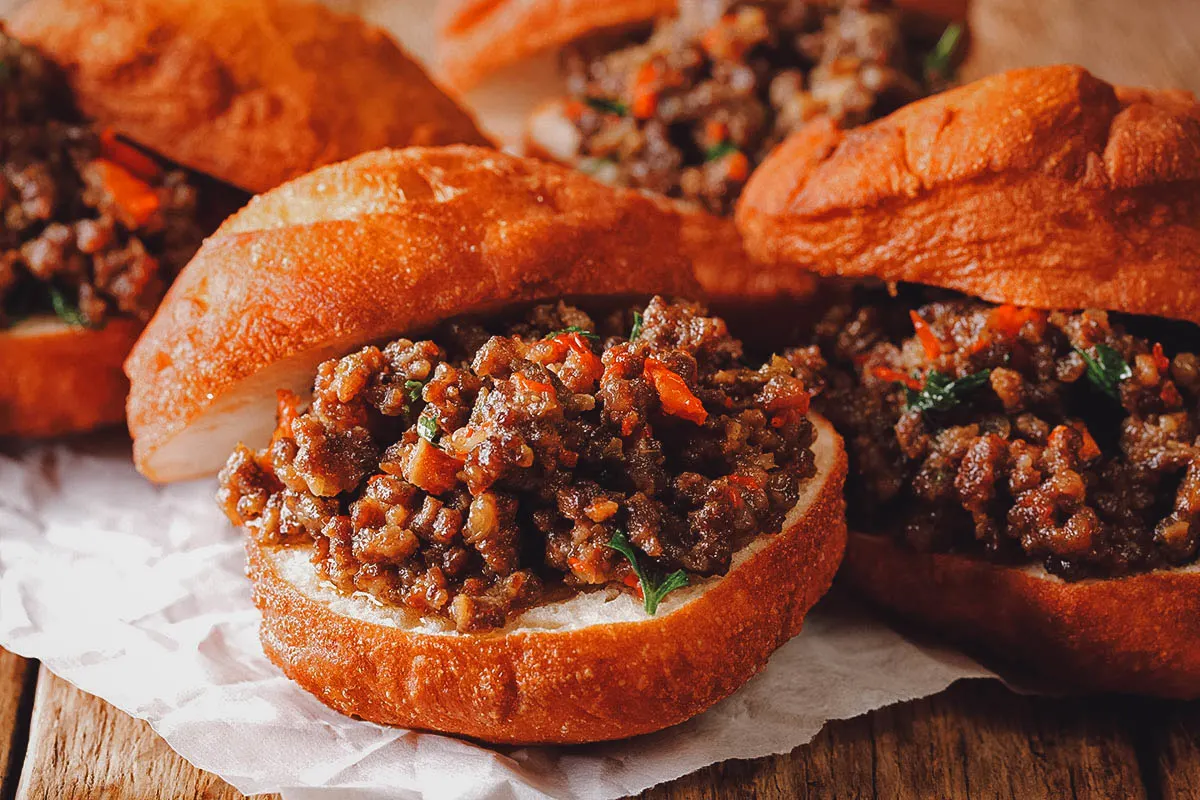
Photo by lenyvavsha
DESSERTS / DRINKS
23. Koeksister
Traveleaters with a sweet tooth will surely enjoy koeksister. It refers to a South African pastry made with braided fried dough coated in a sticky sweet syrup. It’s a popular dessert and a common sight at roadside stalls and supermarkets throughout South Africa.
When you visit Cape Town, be sure to try both versions of koeksister. The type described here is the braided version which is known for its crunchy sweet crust and soft syrupy interior.
Venture into Bo-Kaap and you’ll find a Cape Malay version called koesister that comes in the form of fried dough balls rolled in desiccated coconut.
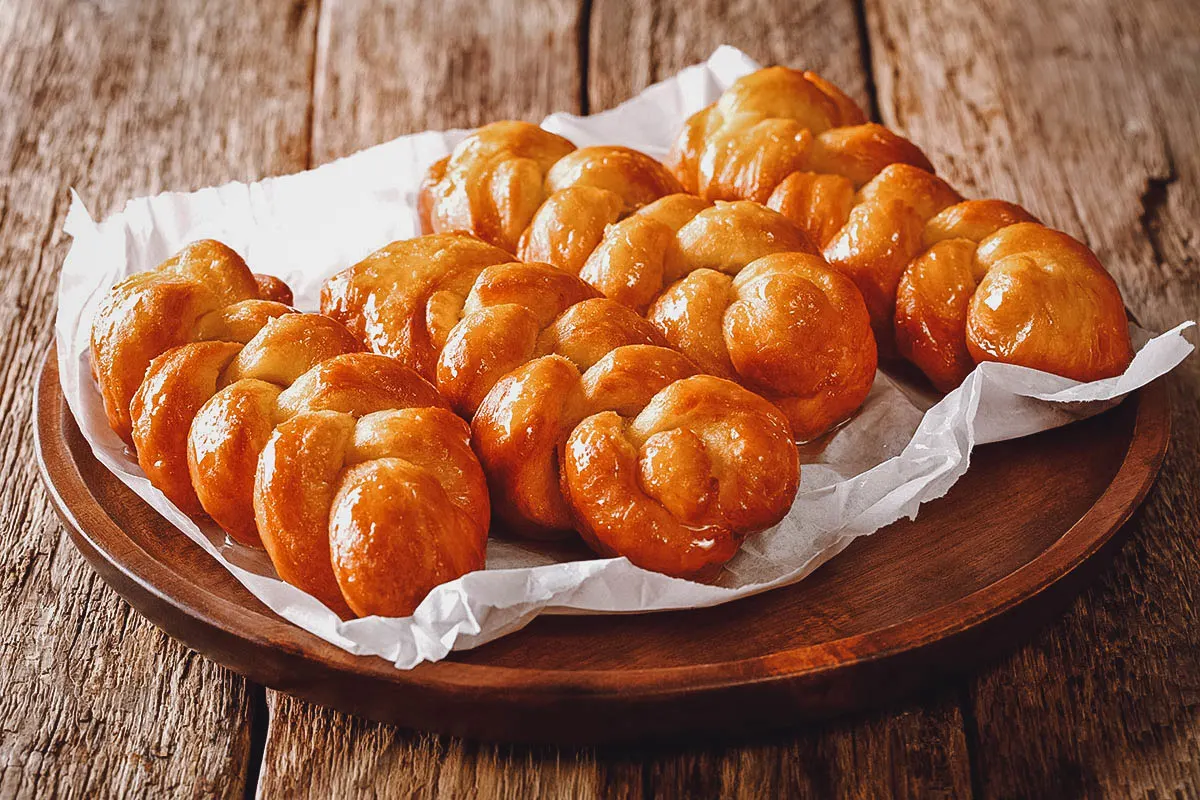
Photo by lenyvavsha
24. Melktert
Meaning “milk tart” in Afrikaans, melktert refers to a classic South African custard dessert made with milk, flour, sugar, and eggs. Topped with a sweet pastry crust and often dusted with powdered cinnamon, it’s similar to a Portuguese egg tart except its lighter and with a more pronounced milky flavor.
Another vestige of the Dutch influence on South African cuisine, the melktert is believed to be a descendant of the mattentaart, a cheesecake-like Dutch dessert. It’s a common sight at South African supermarkets and is perhaps the closest thing South Africa has to a national dessert pie. Eat it warm or chilled. It’s delicious either way.
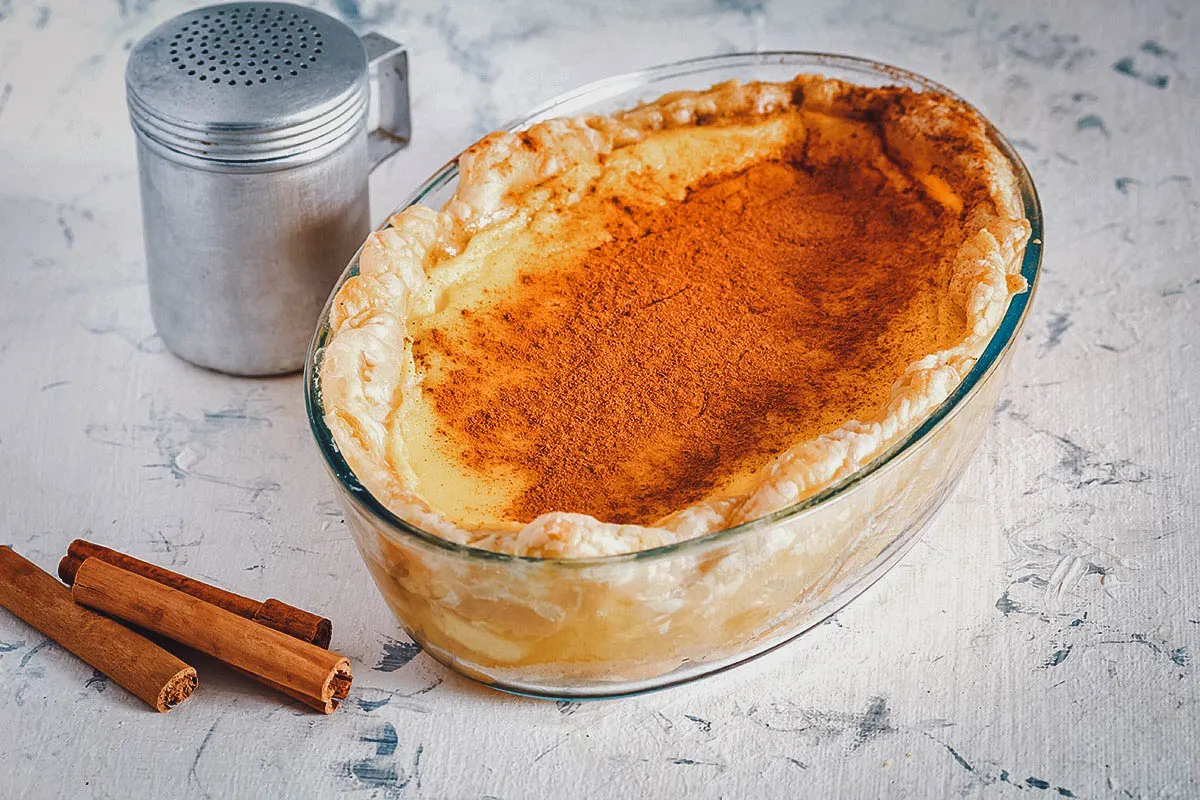
Photo by ToscaW
25. Rooibos Tea
If you’re looking for something to pair with melktert, then look no further than rooibos, a South African herb that’s brewed into a reddish-brown herbal infusion known as “African red tea” or “red bush tea”.
Endemic to the mountainous region of Cederberg, the brewing of rooibos was popularized in the 1700s as an alternative to the more expensive imported black tea. Like any herbal infusion, it’s steeped in hot water to produce a tea-like beverage often enjoyed with milk, sugar, honey, or lemon. But because it’s an herb, its completely caffeine-free and makes a great substitute for caffeinated beverages like coffee or tea.
Often made into cappuccinos, espressos, latte, or iced tea, the flavor of rooibos has been described as smokey, sweet, grassy, and earthy with hints of vanilla.
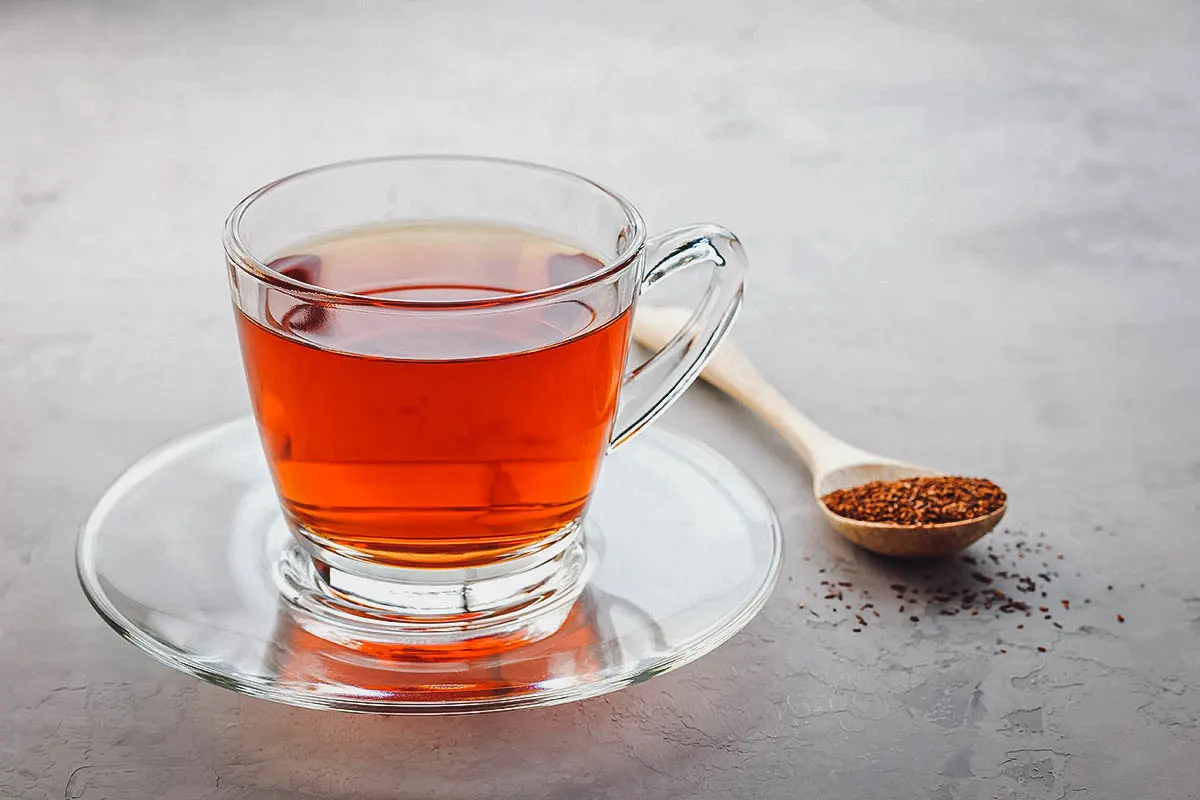
Photo by iuliia_n
SOUTH AFRICAN WINE TOURS
South Africa is known for its wines. Much of its wine production is concentrated around Cape Town so people with a keen interest in wine may want to go on a wine tour. Check out Get Your Guide for a list of wine tours from Cape Town.
FINAL THOUGHTS ON THE FOOD IN SOUTH AFRICA
Safari and adventure may be foremost in people’s minds when they think of South Africa. But as this article illustrates, there’s so much more to look forward to than just lions, elephants, and Cape buffalo. South African food is interesting and diverse and just one more reason why you should visit Cape Town and South Africa.
Disclosure
Some of the links in this South African food guide are affiliate links. If you make a booking, then we’ll earn a small commission at no additional cost to you. As always, we only recommend products and services that we use ourselves and firmly believe in. We really appreciate your support as it helps us make more of these free travel and food guides. Thank you!
Cover photo by RubinowaDama. Stock images via Depositphotos.

